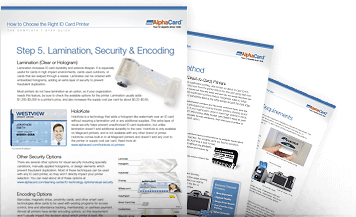Try ID Software for Free
Get 6-week Trial of AlphaCard ID Software
GO TO FREE TRIAL * No credit card neededProximity cards (also known as prox cards or access control cards) are a special type of contactless smart card, used for access control programs – the card unlocks the door by being placed near the card reader instead of using a traditional key.
Proximity cards are durable because they are never scanned or swiped like a magnetic stripe card, greatly reducing the wear and tear that can break or damage cards. This makes them ideal candidates for controlling access to a room or building that employees or other cardholders need to access multiple times per day.
Proximity card encoding is a feature found only in advanced ID card software, and is not a common option. If you need to work with prox cards, study the software features to ensure it will work with the specific type of proximity encoding you need.

How Proximity Cards Work
Each proximity card is encoded with a secure key code number which is transmitted wirelessly using an internal antenna. Most proximity cards have a signal range of 2-15 inches which can be read when placed near a reader, even if the card is inside a purse or wallet.
Proximity card readers translate the card code into a format the electronic door lock can understand. If the data on the card matches the list of valid key codes stored by the proximity system, the door will unlock. Proximity cards can’t be re-encoded, but the list of valid key codes recognized by the access control system can be updated as cards are issued, lost, or retired.
Proximity cards must be ordered from a secure supplier and cannot be encoded in house with an ID card printer; this prevents keycards from being fraudulently duplicated. Some organizations purchase a complete system that includes the cards and readers, or work with a security partner to install readers customized to your card type.
AlphaCard doesn’t offer complete access control systems, but we provide proximity cards that are compatible with existing systems, as well as printers to print on proximity cards.
Proximity Cards Are Best For
- Access Control
- Security
- Public Transportation Passes

Types of Proximity Cards
There are many styles of proximity cards including thick clamshell cards, key fobs, and cards that appear to be normal ID cards. Depending on the style of card you have, you may be able to print on the card with a standard ID card printer. Another option is to print on a thin adhesive ID card that can be adhered to existing proximity cards.
Since different brands of access control system use different of frequencies and formats, it is important to ensure compatibility when purchasing new cards. The best way to ensure compatibility is to look at the packaging of existing cards which will usually include the configuration information.
To order proximity cards you will need to know the brand (Indala, HIDm, Keri, Schlage, etc.), format (26 bit or 37 bit), RFID Frequency (125 kHZ or 13.56 MH), type (clamshell, key fob, tag, standard ISO card), and card sequence. If you are unsure about the card configuration, you can send an existing proximity card to AlphaCard, and we can identify the configuration and provide compatible cards.




